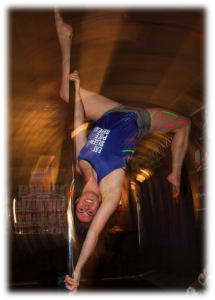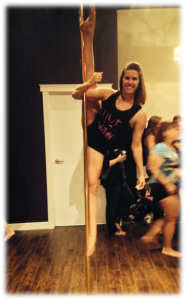Hello! My name is Adrienne Lema, I am a University of Alberta student completing a Bachelor of Physical Education this summer with a practicum here at Pivotal Physiotherapy. I am very interested in exercises and training and I am fairly active, but my training is rather unique. I grew up dancing, swimming, springboard diving, track and field, and have dabbled in some martial arts, but it was circus art that really triggered my intrigue. My most recent training involves pole fitness, some trapeze, and aerial silks. I will be writing a few blog posts through the summer to introduce pole fitness and discuss hypermobile joints. Currently I am a pole fitness instructor with Aradia Fitness1 and have been doing pole fitness for the last 2 years.
Why pole fitness?
Pole fitness is commonly misinterpreted, but it is moving into a new light. It has actually been growing in popularity in the fitness industry, as a result of the muscular strength, endurance, and flexibility involved. The classes are structured with a general warm up and stretch, followed by pole-specific strength exercises and tricks. I find that pole fitness is a strong combination of strength, flexibility, and choreography that suits my interests perfectly. Until I started pole fitness, I never felt so comfortable in my own skin. Pole fitness gave me the opportunity to use my experience as a dancer, but to also incorporate strength I never knew I had. As I went through my first session of classes, I became more confident. It felt great to be trying something new and let some insecurities slip away.
Pole fitness is moving towards being more widely recognized in the world of sports. The Canadian Pole Fitness Association (CPFA)2 put on regional, provincial, and national competitions for pole fitness. They set rules and regulations for these competitions, mandatory moves for different levels or categories of competing, and offer certification courses.
What gets involved?
Pole fitness is a lot of working with and against your own body weight to do all sorts of strength moves, choreography, and spins. The postural muscles are some of the most important muscle groups incorporated with pole fitness. We often hear how important it is to keep a good posture by keeping our shoulders back and down while maintaining a tight core. This is common practice with pole fitness classes as well. Keeping your core strong is essential in pole fitness technique in order to safely prevent excess strain on your back. To minimize risk, it is beneficial to keep a constant reminder, using the little cues of form and posture, especially when performing new moves.
Working against your body weight makes for quite the workout in a pole fitness class. Among others, the main muscles involved include:
• Core
• Back (Latissimus dorsi specifically)
• Rotator cuff muscles and deltoids
• Biceps, triceps, forearms
• Glutes, hip flexors
• Hamstrings, quads, and calves
Flexibility and Hypermobility
As pole fitness is an aesthetic sport, we strive to find appealing movement and lines, sometimes extending beyond what is considered to be a healthy level of flexibility. We train for flexibility alongside strength, and there are certain moves that call for hyper flexibility of a joint. Hypermobility refers to an extension of joints beyond normal capacity (Collins English Dictionary, 2015)3. Flexibility, on the other hand is the amount of motion available at a joint and its surrounding tissues within normal ranges.
Flexibility training is so important to incorporate in fitness plans, but it often gets forgotten. In the case of hypermobility, it can also be overdone. The most important thing to keep in mind is to strengthen what you stretch, and stretch what you strengthen!
In my upcoming blog post, I will be exploring joint hypermobility and safe flexibility training for stability. Thanks for reading!
Adrienne Lema BPE Student
References
1. www.aradiafitness.com (2012)
2. canadianpolefitnessassociation.com (2015)
3. Collins English Dictionary (2015)
Image references:
1. Bloom, David. Edmonton Sun (2015)
2. Lema, Adrienne (2015)
3. Lema, Adrienne (2015)
4. Leen, Isabel. Pole Dancing Adventures, poledancingadventures.com




